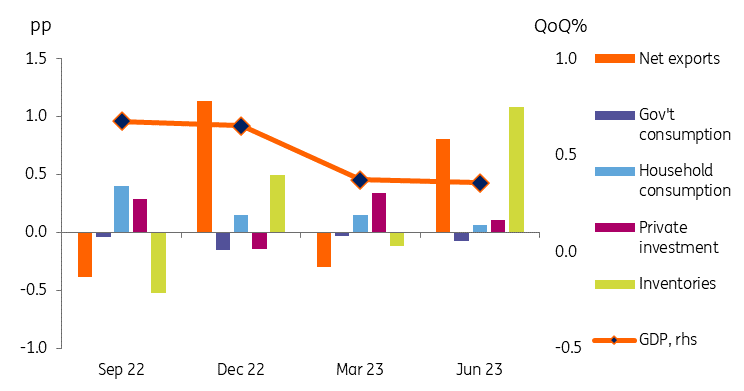Australia: GDP holding up better than expected
2Q23 GDP was stronger than expected, and revisions to past data also show the economy has slowed less than was previously assumed
| 2.1% |
Year-on-year growth rate0.4%QoQ |
| Higher than expected | |
Most of the surprise is in the back series
Australia's 2Q23 GDP data came in stronger than we had expected, with the year-on-year growth rate coming in at 2.1%, not the 1.5% rate we had pencilled in. The quarter-on-quarter growth was also a bit stronger at 0.4% (ING f 0.2%), but it was revisions to the back data that made most of the difference to the annual growth rate.
GDP expanded by 0.1pp more than originally recorded in each of the three previous quarters, which combined with the 0.4% QoQ 2Q23 figure (the same as 1Q23), helped lift the annual growth rate back above 2%.
So far, so good. But when you dig into what was driving growth in the last quarter, things don't look quite so good.
Contributions to QoQ GDP growth (pp)

Weak domestic absorption
The first point to note is that domestic demand ex inventories look very weak in these figures. Private investment and private consumption each only contributed about 0.1pp to the 0.4% GDP total. Government consumption was actually a drag on growth in the second quarter.
Lifting the headline GDP total was a big positive swing in the net export position, mainly a positive boost from exports, with only a small offsetting drag from imports. This export surge coupled with steadier imports (often inputs into the production process), was almost certainly behind the sizeable decline in inventories that prevented overall growth from coming in much stronger.
Exports will struggle to put in such a strong performance again in 3Q23, though we might well see some increase in imports to help fill the hole left by the 2Q23 inventory depletion. These offsetting flows will cancel out to some extent next quarter and any difference in magnitude between the two series will probably provide the bulk of any surprise to next quarter's numbers. As a result, we should probably keep our attention focused on the steadier domestic demand (ex-inventory) figures, otherwise known as domestic absorption.
Nothing much here for the RBA
There is nothing much in these numbers for the Reserve Bank of Australia to chew on. The revised data do suggest that the economy is in a slightly stronger position than was assumed before their publication, and that could keep thoughts of a final rate hike later in 4Q23 from being extinguished completely. But the weak domestic absorption figures don't chime in particularly with the "stronger than expected" thesis, so in total, this probably has little bearing on future RBA rate decisions, or, for that matter the AUD, which didn't respond much immediately after the numbers were released, but has drifted slightly higher subsequently.
This publication has been prepared by ING solely for information purposes irrespective of a particular user's means, financial situation or investment objectives. The information does not constitute investment recommendation, and nor is it investment, legal or tax advice or an offer or solicitation to purchase or sell any financial instrument. Read more
Download
Download snap